


8 months ago
Comic book illustration, a beautiful barbarian woman with blonde hair wearing very tight a halter top and shorts is sitting in a forest next to her huge monstrous dragon with large wings that looks down on her. The background depicts a forest setting. The scene is depicted in the fantasy art style by Russ Mills and Bill Sienkiewicz, with extreme detail and lifelike realism --no elf ears, pants --chaos 45 --ar 4:5 --stylize 750 --v 6.1
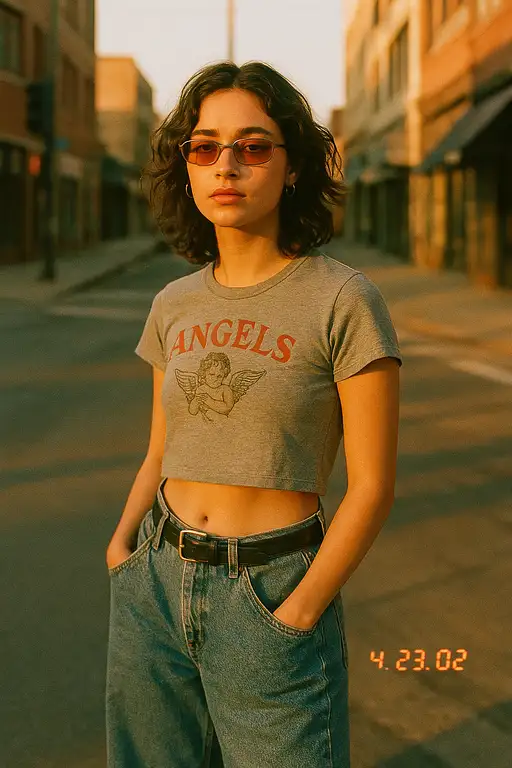
3 months ago
A non-binary person in their 20s with wavy shoulder-length hair and subtle retro makeup stands confidently on an urban 2000s-style street during golden hour. They’re dressed in Y2K fashion: baggy jeans, a cropped graphic tee, and tinted sunglasses, exuding effortless cool. The scene is shot with a Nikon Coolpix 995, built-in lens, auto aperture, at a low and slightly tilted angle, giving it that classic CCD sensor aesthetic — soft tones, pixel bleed, subtle motion blur, and a visible date stamp in the corner. The image is framed in 4:3, evoking the authentic early-2000s digital photo look.

9 months ago
Dynamic, action-packed and award winning 8K science fiction movie scene, where a squad of elite female space marines without helmets and with short hair infiltrates an enemy space station, engaging in intense close-quarters combat against alien adversaries --no helmet --ar 4:5 --stylize 750 --v 6

8 months ago
Best quality, 4k, 8k, highres, masterpiece, extreme detail, realistic, colorful face. Norseman, Clean Viking, small beard, scandinavian looks , full body, wide shot, far into a longhouse, working on woodcarving, animalistic woodcarvings , animation style, psychedelic colors, eye-catching patterns, smooth and dynamic lines, beautifully detailed eyes, lively and energetic characters, unique and bizarre surroundings, expressive facial expressions, dynamic poses, fantasy backgrounds, psychedelic backgrounds, thin brush strokes, soft pastel colors, ethereal lighting, exaggerated proportions, immersive and captivating visual storytelling, mesmerizing and intricate patterns, rich textures and depth, creator, fantasy elements, vibrant fantasy world, emotional and dramatic scenes --ar 4:5 --

6 months ago
A terrified woman stares downward at a swirling black vortex in the center of her stomach, her face frozen in an expression of fear and despair. The vortex distorts the surrounding flesh and fabric, pulling her inward with immense gravitational force. Her torso begins to twist and spiral unnaturally toward the vortex, her arms and head subtly warped as though drawn into an invisible event horizon. Skin and clothing fragment into streaks of light and shadow, trailing around the pull. Her hair is swept into the void, strands unraveling and disintegrating mid-air. Around her body, gravitational ripples warp the air, bending light and forming ghostly echoes of her disintegrating figure. The environment is dark and minimal, as if erased by the void, with surreal, dreamlike lighting—faint, cold illumination highlighting the curvature of her distorted form. Her terrified eyes reflect the infinite abyss within her, a haunting mix of desperation and acceptance. The scene captures a surreal emotional collapse—haunting, dreamlike, and deeply evocative. --v 1.1 --style ultra --quality 2 --ar 3:4
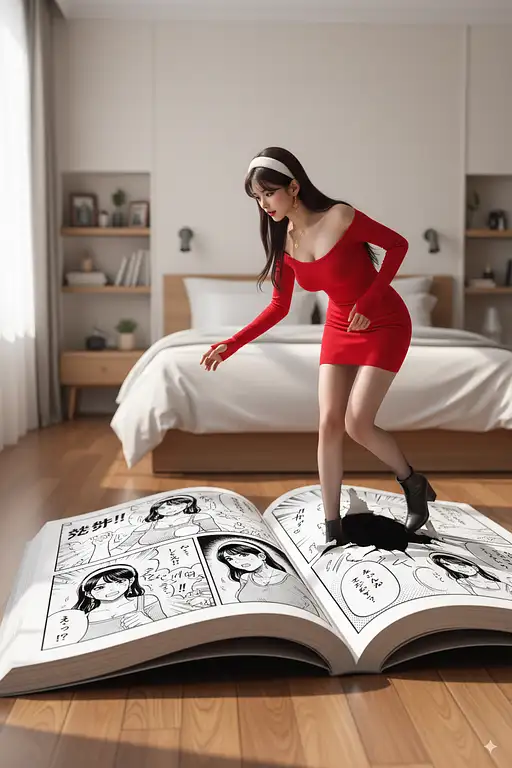
21 days ago
Ultra-realistic 8K scene of the person in the photo, stepping out of and breaking the panel border of a giant open manga book lying on the floor of an aesthetic bedroom. The comic pages depict a surreal 4-panel black-and-white manga with screentones, bold ink lines, and authentic Japanese layout, featuring the manga version of the same person trapped inside. The larger, real-life version emerges dynamically into the comic’s surface, vibrant, colorful, and photorealistic, in sharp contrast to the monochrome manga world. Both versions interact directly, creating a meta, humorous encounter. Highly detailed, crisp manga line art seamlessly integrated with vivid, realistic

4 months ago
Full body cover design with Chara text. Dynamic action scenes. Beautiful girl with semi-long hair in Persona 5 costume. Glowing dark red eyes. Cinematic. Joker. Bloodborne. FromSoftware. Kawaii. --v 4

4 months ago
Full body cover design with Chara text. Dynamic action scenes. Beautiful girl with semi-long hair in Persona 5 costume. Glowing dark red eyes. Cinematic. Joker. Bloodborne. FromSoftware. Kawaii. --v 4

5 months ago
In the style of Yoji Shinkawa, full body shot of a young beautiful European woman with gun and her large robot friend stand on top of their massive mech machine. She is wearing a very tight a halter military top and military shorts and she has short hair. The art style should be colorful and clean and with extreme detail and lifelike realism. In the background there is an epic battle scene between many mechs. High contrast. Dynamic lighting --no rain, snow, water drops, other people --chaos 35 --ar 4:5 --stylize 900 --v 6.1

7 months ago
A woman stands on the subway, captured in motion blur with her reflection visible in an abstract mirror. The background shows blurred train windows and architectural elements of city life. Her expression reflects contemplation or focus as she sits amidst urban traffic. This scene captures everyday human moments within dynamic urban settings, in the style of [Jeanloup Sieff] and [William Eggleston], using an ARRI Alexa Mini camera, --v 6.1 --style raw --ar 3:4 --q 2 --s 100
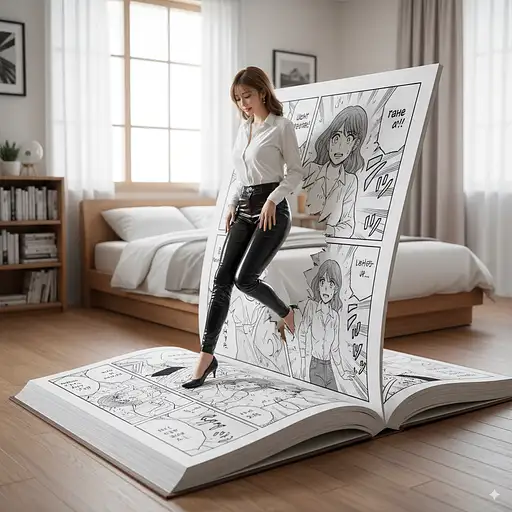
21 days ago
Ultra-realistic 8K scene of the person in the photo, stepping out of and breaking the panel border of a giant open manga book lying on the floor of an aesthetic bedroom. The comic pages depict a surreal 4-panel black-and-white manga with screentones, bold ink lines, and authentic Japanese layout, featuring the manga version of the same person trapped inside. The larger, real-life version emerges dynamically into the comic’s surface, vibrant, colorful, and photorealistic, in sharp contrast to the monochrome manga world. Both versions interact directly, creating a meta, humorous encounter. Highly detailed, crisp manga line art seamlessly integrated with vivid, realistic

8 months ago
imagine A dynamic, behind-the-scenes shot of a creative team collaborating on a project in a modern, loft-style studio in Toronto. There are laptops, design tablets, cameras, and lighting equipment visible. The team members (diverse, stylish, late 20s-30s) are actively engaged in discussion, gesturing, and smiling. The lighting is warm and inviting, with strong highlights and shadows. The color palette includes purple, gold, and pale yellow accents. The overall feel is energetic, collaborative, and professional, but with a touch of urban edge. --ar 3:4 --v 5.2 --style raw
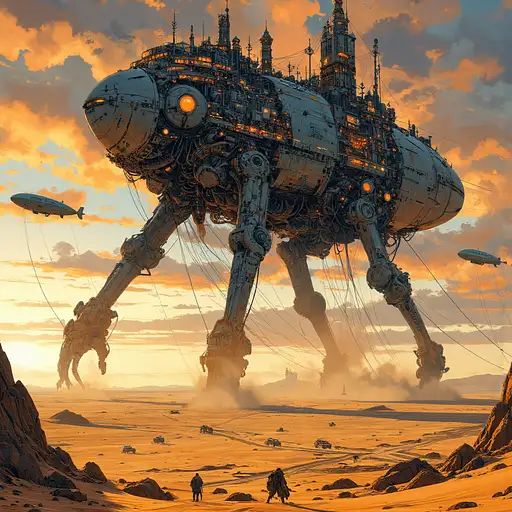
9 months ago
Set against an endless expanse of desert, the colossal automaton strides across the horizon, its immense form towering over the landscape while leaving much of the frame open to convey its overwhelming size. At a distance, its silhouette breaks through low-hanging clouds at 1,000 meters, emphasizing its staggering 4,000-foot height. The machine moves steadily, one leg caught mid-stride, lifted high as cascades of sand pour from its immense foot, creating swirling eddies of dust far below. Its grounded legs leave deep craters in the desert, visible even from this distant view, while the trembling earth sends visible ripples across the dunes. The automaton’s four massive legs are skeletal and mechanical, each a latticework of colossal pistons, cables, and ancient, corroded plating. Despite its distance, the details of its weathered surface are visible: rust streaks running down its joints, broken sections exposing internal mechanisms, and deep scars left by untold centuries of wear. Its torso rises like a fortress, uneven and asymmetrical, with jagged outcroppings, massive exhaust vents spewing steam, and entire sections bristling with exposed machinery. Above the automaton, airships tethered by thick, swaying cables float alongside it, their weathered envelopes bulging against the desert winds. These vessels, far smaller in scale but still large by human standards, bob and shift as they carry supplies and maintenance crews to the machine. Smaller drones flit between the airships and the automaton, their lights blinking faintly as they zip across the sky. On its back, the automaton supports a distant but sprawling city. Even from this far, the city’s intricate design is visible—towers and spires rise unevenly, linked by delicate bridges and suspended pathways. Tiny streams of light flicker across the city’s surface, marking the movements of vehicles and machinery. Trails of smoke and mist cascade down its sides, mingling with the clouds that cling to its upper body. The faint hum of activity is palpable, amplified by the unceasing movement of the automaton itself. The scene is dominated by the vast desert, stretching outward in golden ripples of sand broken only by jagged outcrops of rock and the faint shapes of ruined structures buried in the dunes. In the foreground, caravans of tiny figures and vehicles scatter, barely perceptible against the immense scale of the automaton. Dust storms trail far behind its legs, creating a hazy backdrop that swallows portions of the horizon. Above, the late-afternoon sky is layered with fiery streaks of orange and purple, clouds glowing faintly as they part to accommodate the automaton’s towering frame. The interplay of light and shadow accentuates its enormity, with its upper sections catching the sun’s last rays while its lower half fades into shadow and dust. The atmosphere is thick with the sounds of grinding metal, distant tremors, and the hum of engines, creating a sense of motion and life that fills the frame without overwhelming it. The automaton’s presence dominates the scene, but its distance allows the scale of the environment—airships, desert, and sky—to emphasize its true immensity. It strides forward like a titan, a walking world whose slow, deliberate march carries an ancient city and its tethered fleet across the endless expanse

5 months ago
Create a meticulously staged cinematic scene with rigid symmetry and frontal, low-angle framing, emphasizing a diagonal composition (45-degree tilt) where all elements align along a single dynamic axis. Color Grading: 60% Dominant: Soft, powdery pastel pinks (Pantone 12-1109 TPX "Marshmallow") saturating the sky, snow, and TV casing. 30% Secondary: Frosted teal blues (HEX #6ECEDA) in the glacial lake, aurora, and TV screen static. 10% Accent: Mustard-yellow (Pantone 15-0950 TPX "Golden Glow") in the aurora streaks, wool tufts, and corroded metal knobs. TV Design: A 1950s Bakelite TV (matte eggshell plastic with hairline cracks) tilted diagonally (top-left corner at 10 o’clock, bottom-right submerged at 4 o’clock). Crack: A jagged diagonal fissure (2cm wide) splits the screen from top-left to bottom-right, leaking viscous, neon-bright color bar pigment (RGB values: pink #FF9EB5, teal #5FDAC3, gold #FFD700) that pools into the water below. Materials: Body: Faux-weathered plastic with chipped edges revealing rusted steel underlayers. Details: Three rotary knobs (tarnished brass, 4cm diameter) labeled "VOL," "TUNE," "POWER." Cables: Braided wool cords (undyed cream yarn, 3cm thickness) coiled around the TV’s base, fraying at the ends. Screen Imagery: Static Overlay: A 1953 RCA-style color bar test pattern (8 vertical bands) glitching every 2 seconds, causing the teal and pink bars to "melt" downward into liquid the word "Imagen-4" glitches on the screen Underlying Image: A faint, glowing topographical map (golden-yellow lines on indigo) dissolves into water that cascades from the screen’s crack, merging with the glacial lake. Environment: Glacial Lake: Semi-frozen water (translucent teal, 70% opacity) with jagged ice shards (20cm height) encircling the TV. Snowfall: Heavy, dense snowflakes (1cm diameter) falling at 45 degrees, accumulating on the TV’s top-left corner. Aurora Borealis: Three parallel bands (pink #FFB3D1, teal #7FE5E5, gold #FFE44D) in smooth sine waves, 15° tilt, 80% opacity. Sky: Ultra-high-contrast starfield (ISO 51200 noise pattern) with 2,000 visible stars (randomized 2-4px white dots). Lighting & Effects: Key Light: A frontal, low-orange sodium vapor lamp (3200K) casting sharp diagonal shadows (20° angle) from the TV onto the ice. Bloom: Halation around the aurora and screen, radius 15px, intensity 70%. Textures: Film Grain: 35mm Kodak Vision3 250D overlay (gritty, high-detail). Lens Defects: Two hairline scratches (1px width) at 15° and 75° angles, plus hexagonal lens flare (60% opacity) from the aurora. Physics & Motion: Water: Viscous fluid dynamics—the leaking color bars swirl in 5cm eddies, blending with the glacial lake. Wool: Submerged yarn floats upward in 10cm tufts, swaying at 0.5Hz frequency. Result: A hyper-detailed, reference-free scene that implicitly channels Wes Anderson’s aesthetic through obsessive symmetry, retro-kitsch materials, and a strict 60/30/10 pastel hierarchy—no director named, all style embedded in granular technical specs.

5 months ago
"Create a meticulously staged cinematic scene with rigid symmetry and frontal, low-angle framing, emphasizing a diagonal composition (45-degree tilt) where all elements align along a single dynamic axis. Color Grading: 60% Dominant: Soft, powdery pastel pinks (Pantone 12-1109 TPX "Marshmallow") saturating the sky, snow, and TV casing. 30% Secondary: Frosted teal blues (HEX #6ECEDA) in the glacial lake, aurora, and TV screen static. 10% Accent: Mustard-yellow (Pantone 15-0950 TPX "Golden Glow") in the aurora streaks, wool tufts, and corroded metal knobs. TV Design: A 1950s Bakelite TV (matte eggshell plastic with hairline cracks) tilted diagonally (top-left corner at 10 o’clock, bottom-right submerged at 4 o’clock). Crack: A jagged diagonal fissure (2cm wide) splits the screen from top-left to bottom-right, leaking viscous, neon-bright color bar pigment (RGB values: pink #FF9EB5, teal #5FDAC3, gold #FFD700) that pools into the water below. Materials: Body: Faux-weathered plastic with chipped edges revealing rusted steel underlayers. Details: Three rotary knobs (tarnished brass, 4cm diameter) labeled "VOL," "TUNE," "POWER." Cables: Braided wool cords (undyed cream yarn, 3cm thickness) coiled around the TV’s base, fraying at the ends. Screen Imagery: Static Overlay: A 1953 RCA-style color bar test pattern (8 vertical bands) glitching every 2 seconds, causing the teal and pink bars to "melt" downward into liquid with the word "Prompthero" barely visible on it. Underlying Image: A faint, glowing topographical map (golden-yellow lines on indigo) dissolves into water that cascades from the screen’s crack, merging with the glacial lake. Environment: Glacial Lake: Semi-frozen water (translucent teal, 70% opacity) with jagged ice shards (20cm height) encircling the TV. Snowfall: Heavy, dense snowflakes (1cm diameter) falling at 45 degrees, accumulating on the TV’s top-left corner. Aurora Borealis: Three parallel bands (pink #FFB3D1, teal #7FE5E5, gold #FFE44D) in smooth sine waves, 15° tilt, 80% opacity. Sky: Ultra-high-contrast starfield (ISO 51200 noise pattern) with 2,000 visible stars (randomized 2-4px white dots). Lighting & Effects: Key Light: A frontal, low-orange sodium vapor lamp (3200K) casting sharp diagonal shadows (20° angle) from the TV onto the ice. Bloom: Halation around the aurora and screen, radius 15px, intensity 70%. Textures: Film Grain: 35mm Kodak Vision3 250D overlay (gritty, high-detail). Lens Defects: Two hairline scratches (1px width) at 15° and 75° angles, plus hexagonal lens flare (60% opacity) from the aurora. Physics & Motion: Water: Viscous fluid dynamics—the leaking color bars swirl in 5cm eddies, blending with the glacial lake. Wool: Submerged yarn floats upward in 10cm tufts, swaying at 0.5Hz frequency. Result: A hyper-detailed, reference-free scene that implicitly channels Wes Anderson’s aesthetic through obsessive symmetry, retro-kitsch materials, and a strict 60/30/10 pastel hierarchy—no director named, all style embedded in granular technical specs.
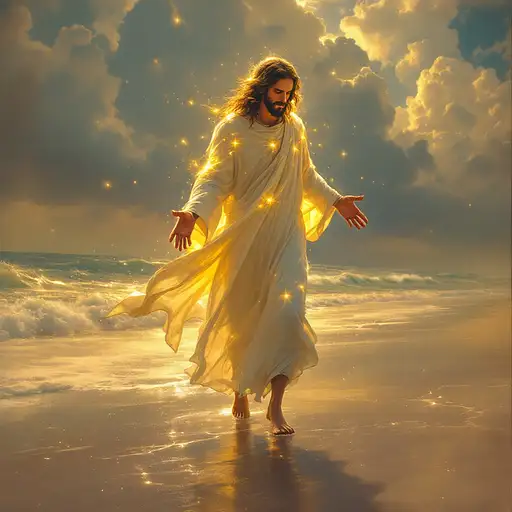
7 months ago
Jesus walking on the beach, not walking on the water, but clearly on the beach next to the water. The perspective will be from behind Jesus as he walks along the beach. Move it a little closer to Jesus so it takes up more space in the frame. In the following example you can see one of the palms of his hands and you can see the sole of one of his feet. Paint a small hole clearly visible in the center of her hand and in the center of her foot she has holes in her hands and feet where nails would have been pierced but light appears in her. This is a painting of the RISEN LORD. golden colors and light shine golden light from pleyada starsand from the heaart golden light conecting . colors, ethereal lighting, exaggerated proportions, immersive and captivating visual storytelling, mesmerizing and intricate patterns, rich textures and depth, creator, fantasy elements, imaginative and vibrant world, emotional and dramatic scenes --ar 4:5 --s 250
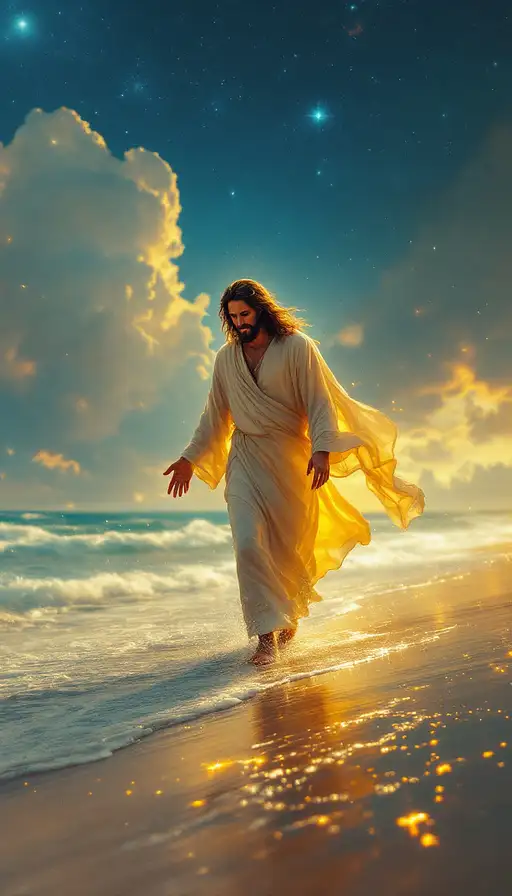
6 months ago
Jesus walking on the beach, not walking on the water, but clearly on the beach next to the water. The perspective will be from behind Jesus as he walks along the beach. Move it a little closer to Jesus so it takes up more space in the frame. In the following example you can see one of the palms of his hands and you can see the sole of one of his feet. Paint a small hole clearly visible in the center of her hand and in the center of her foot she has holes in her hands and feet where nails would have been pierced but light appears in her. This is a painting of the RISEN LORD. golden colors and light shine golden light from pleyada starsand from the heaart golden light conecting . colors, ethereal lighting, exaggerated proportions, immersive and captivating visual storytelling, mesmerizing and intricate patterns, rich textures and depth, creator, fantasy elements, imaginative and vibrant world, emotional and dramatic scenes --ar 4:5 --s 250
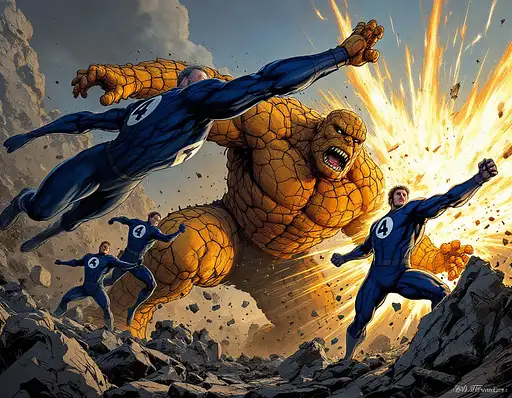
8 months ago
A **highly detailed, action-packed scene** featuring the **Fantastic Four** in their **classic blue suits** with the iconic **white “4” emblem**, staying true to **Jack Kirby’s original comic book style**. The team is dynamically posed in a moment of **high-stakes action** against a **colossal cosmic threat**. - **Mr. Fantastic (Reed Richards)** is at the forefront, his **body stretching and twisting in impossible ways**, extending across the battlefield with an **elongated arm grabbing a collapsing piece of debris**. His **face shows intense focus**, and his **gray temples stand out against his dark hair** as he strategizes under immense pressure. - **The Thing (Ben Grimm)** is mid-action, his **massive orange, rock-like form braced against a powerful shockwave**, throwing a **devastating punch** at an enemy with his signature battle cry: **"IT’S CLOBBERIN’ TIME!"** His **rocky hide is intricately detailed**, with **realistic cracks and depth**, giving him a **monolithic, powerful presence**. - **Human Torch (Johnny Storm)** is soaring through the sky, his **entire body engulfed in flames**, leaving behind a **bright, fiery trail**. His **eyes glow intensely with fire**, and he hurls a **controlled stream of fire** at an **approaching enemy spaceship**, his famous catchphrase **"Flame On!"** integrated into the energy burst. - **Invisible Woman (Sue Storm)** stands confidently, her **hands raised as she generates a massive, shimmering force field** to shield her teammates. The **transparent energy distorts light realistically**, with **subtle glowing edges**, while another force field encases **a group of civilians she is protecting** from falling debris. The backdrop is a **dramatic cosmic battleground**, possibly **New York City under siege**, or **outer space**, with a **menacing Galactus, Doctor Doom, or Annihilus looming in the background**. The colors are **bold and vibrant**, using **classic Marvel comic book shading and inking techniques** to capture the **nostalgic, dynamic energy of a 1960s-70s Fantastic Four comic book cover**. The **camera angle is dynamic and slightly tilted**, emphasizing **perspective, scale, and movement** as **debris flies, energy beams streak across the air, and the Fantastic Four’s abilities explode into action**. The **lighting is high-contrast and dramatic**, blending **classic comic panel aesthetics with a modern, cinematic feel**, incorporating **motion blur and deep shadows** for enhanced realism while **retaining the comic book charm**. A **masterpiece of superhero action**, blending **hyper-detailed comic book stylization, cinematic intensity, and larger-than-life cosmic storytelling**. **Ultra-detailed 8K resolution, trending on ArtStation, with Unreal Engine 5-level fidelity. Vertical aspect ratio.**

5 months ago
A fantastical landscape emerges from the form of a violin lying horizontally on a calm body of water. Lush green hills and rocky cliffs rise from the guitar's body, complete with cascading waterfalls flowing into the surrounding water. A miniature sailboat glides near the guitar's bridge, and tiny figures stand on a small platform overlooking one of the waterfalls. The violin's neck extends upwards, seemingly touching a cloudy sky where several birds are flying. The bow for the violin acts as a bridge to another world. The overall scene blends musicality with the serenity of nature in a surreal and captivating way. --chaos 20 --ar 3:4 --stylize 0 --draft

6 months ago
A detailed and atmospheric illustration, full body shot of a young beautiful European female horned villains, in a desolate desert. full body dynamic pose, dramatic, the character has large, ornate horns with metallic jewelry and flowing armor covered in elaborate patterns, belts and loincloth. The scene is lit with a warm, golden glow from the moon, creating deep shadows and a dramatic effect. The background features a starry night sky and desert dunes, this is a dark fantasy artwork, extremely detailed background, inspired by Brom and Adrian Smith --ar 4:5 --style raw --profile 1gvkuc8 --stylize 500 --v 6.1

9 months ago
A small spacecraft landing on the surface of an alien planet, with tall ancient structures rising in front of it. The scene is set against a blue sky and white desert background. There's no one around, but there's a person standing next to their ship, looking at the structure. The style should be realistic, focusing more on realism than fantasy. --chaos 100 --ar 4:3 --style raw --stylize 750 --v 6.1
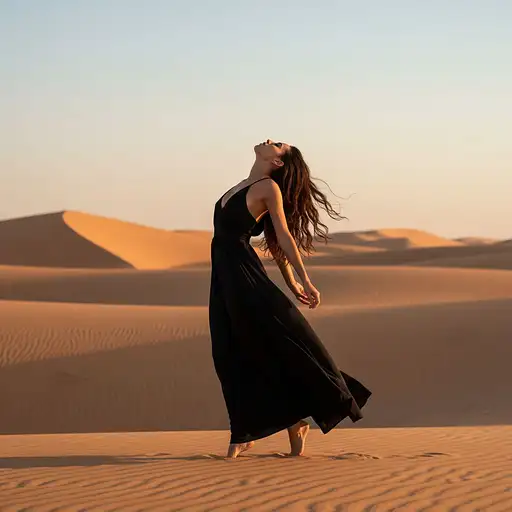
27 days ago
Absolutely! Here's your **enhanced and highly detailed AI art prompt**, incorporating **depth of field, 4K resolution, and a Hasselblad 4D camera style** for a hyper-realistic and professional feel: --- **🎨 AI Art Prompt:** *A stunning woman standing alone on a vast, undisturbed desert landscape during golden hour. She is wearing a long, flowing, sleeveless black dress that gently touches the sand. Her bare feet press softly into the rippled dunes. Her body is arched slightly backward in a graceful pose, arms relaxed and extended behind her, head tilted back toward the sky in a moment of liberation. Her long, dark hair is captured mid-motion, flowing wildly in the desert wind. The backdrop features expansive, rolling sand dunes with soft gradients of light and shadow. The warm sunlight casts a golden-orange hue across the dunes and the woman's figure, adding depth and contrast.* *Shot in ultra-high resolution with shallow depth of field using a Hasselblad 4D medium-format camera, the background is slightly blurred, drawing focus to the sharp, detailed subject in the foreground. The image is rendered in crisp 4K quality, showcasing rich textures in the sand, fabric, and hair. The sky is a soft pastel gradient, transitioning from peach near the horizon to light blue higher up, with no clouds present. The entire scene is cinematic and emotionally evocative, blending realism with an almost surreal sense of freedom and solitude.* --- **Optional Settings/Tags for AI Tools:** * **Camera Type:** Hasselblad 4D, medium format lens * **Resolution:** 4K, ultra-detailed, photorealistic * **Depth of Field:** Shallow, focused on subject, blurred background * **Lighting:** Golden hour, soft and directional * **Style:** Fine Art Photography, Cinematic, Vogue Editorial * **Aspect Ratio:** 4:5 or 3:2 * **Mood:** Empowering, introspective, serene, majestic * **Environment:** Remote desert, warm tones, wind-blown atmosphere

14 days ago
Create a 3:4 vertical hyperrealistic poster featuring a hijab-wearing Indonesian woman from [FIGURE 1]. The poster presents a unified composition of her, rather than separate stills: Foreground: A smaller full-body image of her. Background: A larger, more serious close-up of her face. The design should feel cohesive and natural, as if both versions were part of the same scene, not tacked-on elements. Lighting & Ambiance: A dark, somber background with warm orange stage lighting that highlights the beautiful hijab-wearing woman. The tone is artistic, cinematic, and emotional, emphasizing the drama of the concert. Focus on natural blending, harmonious scale, and realistic perspective for both figures. Style: A hyperrealistic, dramatic, cinematic professional concert poster.
